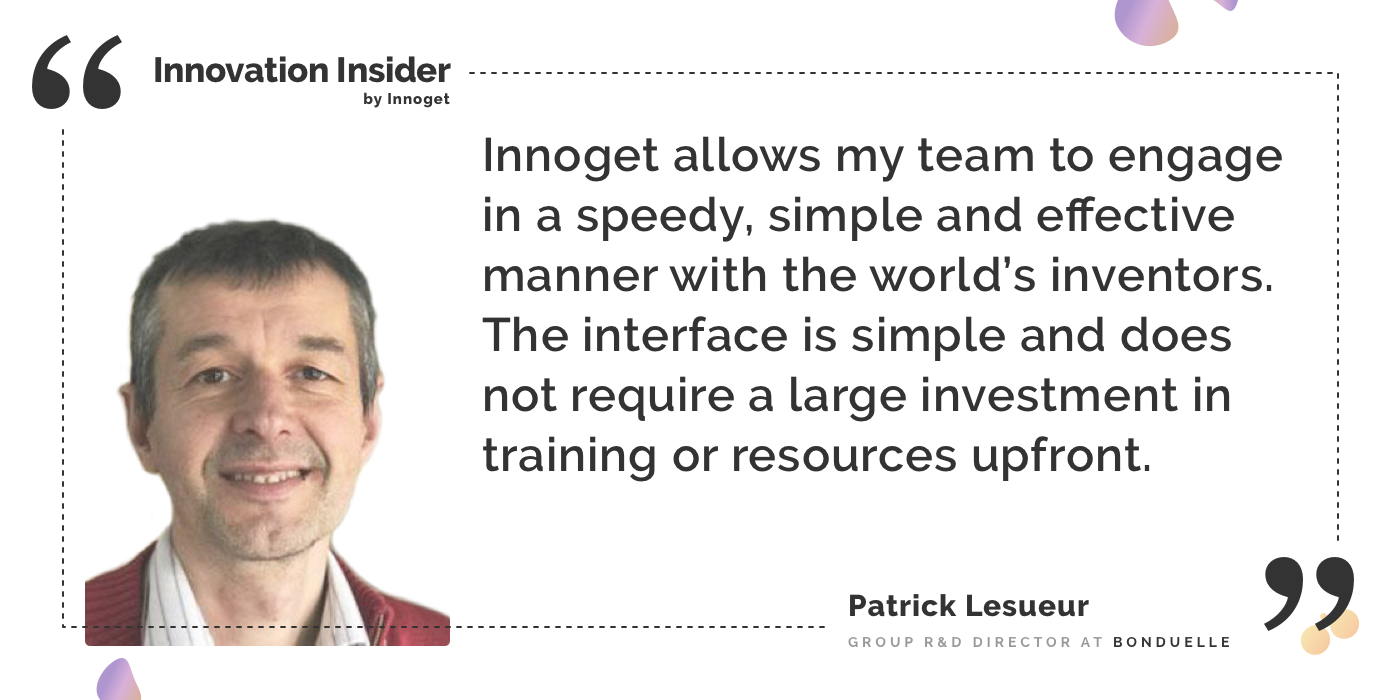Innovation Insider: Talking with Mr. Patrick Lesueur, Group R&D Director at Bonduelle
We are tracking down Innoget users in the world's most amazing companies to discover their thoughts on open innovation, where they see open innovation is headed, and learn more about how is the innovation culture within their organization.
Therefore, this month we interviewed Mr. Patrick Lesueur, Group R&D Director at Bonduelle, the French family-owned and stock-listed food company with a turnover of €2.7 bn operating in Europe, North America, and Russia. Bonduelle’s mission is to bring well-being though plant-based foods, historically from vegetables but more and more from any plant-based foods such as pulses, cereals,... Bonduelle now operates in 3 technology areas: chilled foods(45% of TO), canned foods (33%) and frozen foods (22%).
Patrick, can you briefly describe your role within Bonduelle and how do you define open innovation?
I am responsible for the Group R&D and Open Innovation teams. My mission is to invent the future of the company through new products or services. Some of it may come from internal but the vast majority will have an external element. I would define Open Innovation as a set of tools to steer your innovation engine, accelerating the emergence or developments of new opportunities.

Patrick Lesueur, Group R&D Director at Bonduelle / Innoget, Patrick Lesueur
Where do you see open innovation headed and how do you think organizations can prepare for where it is going?
Open Innovation may be seen as a process or a set of tools but really it is a mindset and I think the future of Open Innovation is to disappear into the “standard” ways of innovating at companies and become the norm. It means the scientists or researchers of the future need not only to be expert in their field but also very well networked with academics but also entrepreneurs and experienced with collaboration and what a genuine win-win is and takes.
In the end, OI is about creating options in technology development in no-time and shaking the internal status-quo, hereby forcing decisions on what and what not to do. When done well, it accelerates decision making and therefore tremendously accelerates the speed, agility and in the end innovation speed.
Based on your expertise, what are the key elements to implement a successful open innovation strategy?
"Strategy" is really about making decisions between different choices.
The first and most crucial element is internal and is about understanding the business strategy and the R&D strategy required to drive it. From this phase will come the company's needs and its strategic capability area.
The second phase is still pretty internal, identifying the areas and needs that the company wants to own and where it will not collaborate, the areas where it has some degree of knowledge and some insights on whom/where to collaborate at a more granular level and areas where it has very limited knowledge and would be fully ready for a collaboration with a strategic partner in this field.
Once you have that, the elements are really to understand the maturity of Open Innovation in your organization and R&D community and what the best approach is (centralized or distributed model).
Once you have this, the rest is really about execution with a clear mandate from top management.
What is the open innovation culture like in your organizations?
Bonduelle was until recently a very, very large SME and not yet a big multinational. It therefore never had the internal resources to think it had all knowledge inside and could build walls around itself, so we don’t suffer too much from the non-invented Here syndrome. What we now, however, is that Open Innovation requires some specific skills and discipline.
Can you share anything about how Innoget helps open innovation activities?
Innoget allows my team to engage in a speedy, simple and effective manner with the world’s inventors, eg academics, entrepreneurs,...The interface is simple and does not require a large investment in training or resources upfront. The leads we get from Innoget are the odds ones out, either completely stupid or missing the point or absolutely brilliant and exceptional. I would add the best is when they have both but you only find out on the way.

